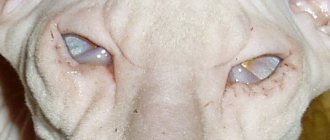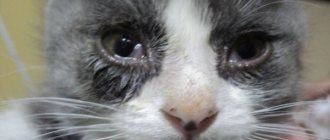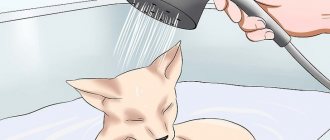Low or high body temperature in sphinxes can signal serious health problems that need to be eliminated as soon as possible with medications. If the temperature does not stabilize over the course of several days, and the cat experiences fever, fever, nausea and other unpleasant symptoms, then you should not delay contacting the veterinary clinic.
What is normal temperature?
The Canadian and Don Sphynx have the same body temperature as other breeds of the cat family. Many owners believe that a cat’s normal temperature should be 42 degrees, but this opinion is erroneous. Such speculation arose due to the fact that when you touch the skin of the sphinx, it is very hot. The normal temperature for this breed is 38-39 degrees, and anything lower or higher than normal is pathological.
Veterinarians note that the temperature of Sphynx kittens may be slightly higher than that of adults by 0.5 degrees. This is explained by the active processes of growth and development in a young body.
Owners should regularly monitor their thermoregulation, as this is a problem area for Sphynx cats due to their lack of fur. It is especially important to monitor the body temperature of young cats, since kittens are not able to carry out normal thermoregulation and even if it is 18 degrees in the house or outside, they can become hypothermic and get sick. If the case is advanced and veterinary care is not provided on time, the sphinx may die.
In winter, animals look for cozy, warm places, and in the hot season, on the contrary, cool ones.
Adults are able to regulate the heat exchange of their own body, and in winter they hide in warm places, and in summer they try to find coolness. All Sphynx owners should know that it is not recommended to expose them to drafts, as there is a high risk of hypothermia. Against the background of a significant decrease in temperature, the cat develops rhinitis, laryngitis, and pneumonia.
Causes of low temperature
The main reason for a cat's temperature drop is hypothermia. It is more dangerous when the animal was walking on a cold, damp street: the fur gets wet, the warming air layer disappears, and the cat begins to freeze.
If a kitten or an elderly cat finds itself in unfavorable conditions, then it is more difficult for them to maintain normal temperature readings in cold weather. An older cat may have liver or kidney disease, which also results in hypothermia.
Other reasons include various pathologies of the body, exhaustion, starvation, massive blood loss, internal bleeding, heart and vascular diseases, cancer, viruses, and nervous diseases.
We recommend reading: Yellow crusts on a puppy’s head
Signs of hypothermia
A low temperature in a Sphynx can be fatal if the owner does not notice the problem in time and does not contact a veterinarian. When hypothermia occurs, the temperature drops to 37 and below; the critical mark on the thermometer is 28. Pathology can be recognized by additional symptoms:
- weak palpation of the pulse;
- rare breathing;
- pale mucous membranes and skin;
- trembling in the muscles of the Sphinx;
- poor sensitivity;
- lethargic and apathetic state;
- wide pupils.
Breed standard and description
This breed's standards allow for little hair on the skin by the age of two. The amount of fur on an animal’s body depends on the time of year, hormonal levels, and room temperature.
There are strict standards establishing the description of the Don Sphynx breed. The animal's body has an athletic, raised shape with well-developed muscles. The croup should be wider than the shoulders, but the silhouette itself is elongated. The head, neck, and armpits have folds of skin resembling wrinkles. Males are larger than females, the average weight of a male is 7 kg, females - about 5 kg.
Naked sphinx
Velours
Brush
The skin is pleasantly smooth and feels hot to a person. The Sphynx has a higher body temperature than other cat breeds. For him, this is the norm and in this case there is no need to show the pet to the veterinarian.
The skin contains the pigment melanin, thanks to which the sphinx tans, and from an overabundance of the sun even burns from ultraviolet radiation form. An animal can sweat over the entire surface of its body. The legs are of medium length, the toes are elongated, reminiscent of human ones. The tail is long, straight, tapering to the tip.
The head is wedge-shaped, clearly defined cheekbones with a straight nose and chin. The Sphynx's ears are large and tilted forward, but not too much. The eyes should be slightly slanted and almond-shaped. Eye color can be any. The cat's whiskers are small and slightly curly. An animal may also have no whiskers at all.
Table of Don Sphynx standards.
Don Sphynxes live on average 13-15 years, but there are long-lived individuals who have lived for more than 20 years.
How to help your pet and raise the temperature?
You can stabilize body temperature after hypothermia by covering your pet with a warm blanket.
If the owners find symptoms of hypothermia and a low temperature in the Sphinx, then they need to know how to help their pet at home. First you need to wrap your pet in a warm blanket, blanket or towel to warm him up and stabilize his temperature. Place the sphinx in a chair or other warm corner. In case of severe hypothermia of the cat's body, apply a heating pad to the cold back of the animal. If possible, it is recommended to give the cat warm water to drink. When he refuses to drink the liquid on his own, you can try to inject it into the animal using a syringe. It is worth monitoring the condition of the sphinx and if there is a significant decrease in temperature and pathological signs, it is necessary to immediately take the pet to a veterinary clinic.
Thermoregulation of the Sphynx
The issue of thermoregulation for sphinxes is quite acute. Maintaining a constant body temperature for sphinxes is a vital issue. If overcooled, sphinxes can die from pneumonia, and if overheated, from heatstroke.
Newborn Sphynx kittens are not able to maintain their body temperature on their own . Without maternal warmth, even at a temperature of + 18 °C, they can die from hypothermia. Kittens warm themselves from their mother cat. And when it’s hot they creep apart from each other. It is during the suckling period that Sphynx kittens learn to seek warmth and maintain a constant body temperature using an external heat source.
The normal body temperature of a Sphynx kitten is on average from 38.5 to 39.5 °C. In a growing body, metabolic processes occur faster, and therefore the body temperature is higher. In adult cats, this figure ranges between 38.0 and 39.0 °C. If the external environment somehow affects the cat’s body, be it cold or heat, the animal will take measures to normalize its body temperature.
If the Sphynx is cold , it will look for a source of warmth, like a newborn kitten. Sphinxes can bask in the sun, on a radiator, or on any device that produces heat. For heating, they use a dog or any other animal as a living heating pad without any complexes. But the most pleasant thing for a sphinx is to stay warm, clinging to its beloved owner.
It must be remembered that in hairless cats, things are much more complicated with thermoregulation. The Sphinx must be protected from drafts in cool weather. And in hot weather, make sure that the Sphynx does not overheat, because the lack of fur contributes to faster overheating.
HOW TO HELP THE SPHINX SURVIVE THE HEAT
In summer , sphinxes feel quite comfortable . However, the room must be ventilated: during periods of abnormal heat, do not forget to leave the windows open.
When the Sphynx is hot , he sleeps all the time, at times moving from shade to sun and vice versa - this is how cats regulate their body temperature. Therefore, there is no need to drive your pet away from the sunny windowsill, trying to put it in the shade. But make sure that the Sphynx does not doze for too long under the scorching rays of the sun, so he can get heatstroke in his sleep, and he will not have the strength to move to the cooler area of the house.
If the sphinx does not have the opportunity to get away from the heat , then its breathing quickens. The cat may begin to breathe rapidly—up to 250 breaths per minute—while keeping its mouth open and its tongue slightly protruding, like a dog. But this method of cooling through breathing causes loss of fluid from the body, which further leads to dehydration.
Drinking water when the external temperature rises not only helps the sphinx cool down , but also prevents the development of dehydration due to rapid breathing. Therefore, it is very important in hot weather to remember to change the water as often as possible and always make sure that the bowl is full.
Some sphinxes like to take baths in the summer , washing themselves with cool water flowing from the tap. If your Sphynx is a fan of such water procedures, do not forget to turn on the water in a thin stream several times a day, but you should not force the cat to bathe.
Make sure that the sphinx does not fall asleep under the air flow from a fan or air conditioner .
HEAT STROKE: SYMPTOMS AND FIRST AID
- the sphinx often breathes like a dog, with its mouth open - this is a very alarming sign; such breathing is unusual for cats;
- the sphinx lies stretched out, spread out, does not respond to the sounds and voice of the owner, to touch; if the sphinx does not lie down, but tries to go somewhere, but its movements are constrained, this indicates that it is disoriented;
- the sphinx breathes frequently, but shallowly;
- pulse is threadlike;
- the pupils are dilated, do not respond to light, the mucous membranes are scarlet or, conversely, pale;
- The Sphinx's body temperature is above 39 degrees.
We recommend reading: How long does it take for oxytocin to work in dogs?
If, despite all precautions, the sphinx still receives heatstroke , you need to immediately help him cool down. This is not difficult to do - wrap the sphinx in a cool wet towel and take it to a cool room, give it a drink of cool water, and lightly wipe the pet’s face and body with it. Remember that overheating can lead to swelling of the lungs and brain, so the Sphynx needs to be taken to a veterinary clinic immediately , even if he has woken up and you think he is feeling better.
HOW TO HELP THE SPHINX SURVIVE THE HEAT
Fever: symptoms
Various diseases, overheating and other factors can affect the increase in temperature of the Sphinx. As a result, the temperature rapidly increases to 39 degrees and above. This condition of a pet should not be left unattended, as it can cause serious complications and can cause the death of the pet. Heat stroke can be recognized by the following clinical picture:
- frequent breathing and shortness of breath for no particular reason and at rest;
- the sphinx breathes through her mouth, with her tongue hanging out of her mouth;
- insufficient depth of inspiration;
- delirious state, the pet is looking in an unknown direction;
- disorientation in space;
- changed color of the mucous membranes, which can be from rich color to whitish;
- weak pulse, and heartbeats are almost impossible to count.
At elevated temperatures, the sphinx is constantly in a lying position, and it is difficult for him to make any movements. When the owner calls him, there is no reaction.
How to bring down the temperature?
At home, a wet towel in which the cat is wrapped will help reduce the indicators.
If your pet has a very high body temperature and pathological symptoms are observed, it is recommended that you contact a veterinarian as soon as possible. The clinic will conduct a diagnosis, find out the reasons for the increase in temperature and select a treatment that will help bring down the readings on the thermometer and eliminate the underlying disease. At home, it is possible to alleviate the condition of a pet by performing the following actions:
- Wrap your pet in a wet towel or blanket to reduce symptoms of heat stroke.
- Carefully wipe the sphinx's face and ears using cotton pads.
- Place the animal in a cool place, but not too cold, so that sudden hypothermia does not occur.
- They try to give him cold liquid to drink. You can use an ice cube that your cat can lick.
Even if using home methods it was possible to bring the cat’s temperature back to normal, you should contact a veterinary clinic, since such a case is the first sign of serious illness in the animal. With advanced overheating, this type of cat has a high risk of swelling of the brain and lungs. Elevated temperature is especially dangerous for kittens, which may die if their condition is not stabilized in a timely manner.
Treatment of fever in a cat
Neither hypothermia nor hyperthermia should be ignored. As stated above, there are serious reasons for a decrease or increase in temperature that must be found and eliminated. It is better to consult a veterinarian: you may need to conduct an examination and undergo tests.
How to increase the temperature
A frozen and shivering cat is brought into a warm room. The wet fur is dried with a hairdryer.
A kitten with hypothermia urgently needs to be warmed in any way: a blanket and heating pads will do. You can simply hold your baby close and wrap yourself up with him. An adult cat also needs warmth. Be sure to offer warm drink and food after the animal stops shaking.
If the low temperature lasts for a long time or the indicators have dropped significantly, the animal should be taken to a veterinary clinic rather than trying to treat the cat at home.
With a slight increase in body temperature, cats do not fuss and do not knock it down. But a significant increase signals that it’s time to intervene. High values on the thermometer threaten the cat's body with dehydration, which is fraught with the worst consequences.
There are several tips to help reduce your cat's fever:
- the wool is slightly moistened;
- Ice is applied to the neck and inner thighs;
- Give the cat a cool drink.
If there is no decrease, the animal is shown to a specialist.
Many people believe that Sphynx cats are radically different in their physiology from other cats. There are also many publications both on the Internet and in print media that, to put it mildly, are misleading. I want to debunk some of the most common myths about sphinxes.











